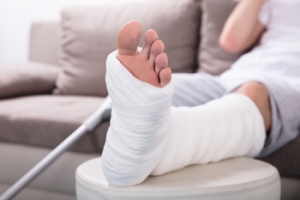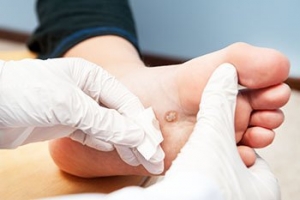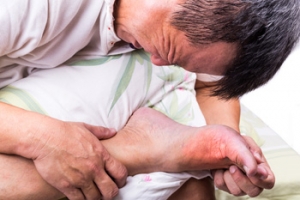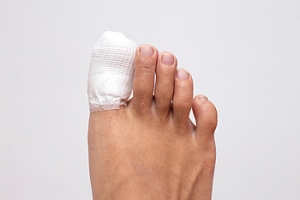283 St Rose Ave
Windsor, ON N8S 1X1

Necessary Care for a Broken Foot
 A broken foot can happen as a result of falling or enduring a sudden injury. The healing process can begin when a proper diagnosis is performed, which generally means having an X-ray taken. This is commonly followed by wearing a protective boot or cast, and it may help existing swelling when the foot is frequently elevated. The boot or cast may aid in walking while attempting to complete daily activities. If the fracture is severe, and the bone is protruding from the skin, surgery may be necessary for proper healing. It is suggested that you consult with a podiatrist if you have broken your foot.
A broken foot can happen as a result of falling or enduring a sudden injury. The healing process can begin when a proper diagnosis is performed, which generally means having an X-ray taken. This is commonly followed by wearing a protective boot or cast, and it may help existing swelling when the foot is frequently elevated. The boot or cast may aid in walking while attempting to complete daily activities. If the fracture is severe, and the bone is protruding from the skin, surgery may be necessary for proper healing. It is suggested that you consult with a podiatrist if you have broken your foot.
A broken foot requires immediate medical attention and treatment. If you need your feet checked, contact the practitioners from Foot Care Institute. Our practitioners can provide the care you need to keep you pain-free and on your feet.
Broken Foot Causes, Symptoms, and Treatment
A broken foot is caused by one of the bones in the foot typically breaking when bended, crushed, or stretched beyond its natural capabilities. Usually the location of the fracture indicates how the break occurred, whether it was through an object, fall, or any other type of injury.
Common Symptoms of Broken Feet:
- Bruising
- Pain
- Redness
- Swelling
- Blue in color
- Numbness
- Cold
- Misshapen
- Cuts
- Deformities
Those that suspect they have a broken foot shoot seek urgent medical attention where a medical professional could diagnose the severity.
Treatment for broken bones varies depending on the cause, severity and location. Some will require the use of splints, casts or crutches while others could even involve surgery to repair the broken bones. Personal care includes the use of ice and keeping the foot stabilized and elevated.
If you have any questions please feel free to contact our office located in Windsor, ON . We offer the newest diagnostic and treatment technologies for all your foot and ankle needs.
Causes, Symptoms, and Treatment for a Broken Foot
One out of ten broken bones is reported to be in the feet. When an object crushes, bends, or stretches the bone beyond acceptable ranges, bones break. A break in the foot is either a fracture or a straight break.
The location of any break can tell you how the break happened. Toes, for instance, break typically as a result of something being kicked hard and with great force. Heel breaks almost always are a result of an improper landing from a tall height. Twists or sprains are the other two frequent occurrences. As with all usual breaks, they result from unexpected accident or sudden injury. As with stress fractures, breaks form as a process over time from repeated stress on already present cracks. Runners, dancers, and gymnasts are the usual athletes who receive this type of break. Stress fractures result from incredible pressure on the feet. It is no surprise these athletes bear the majority of reported fractures.
Pain, swelling, bruising, and redness are all indicative of the typical symptoms from a broken foot. Severe pain—to the point of not being able to walk—usually depends on the location of the break in the foot. Toes are on the lower scale of pain threshold, but heels are high, as are a few other particular bones. As the severity of the broken foot increases, symptoms like blueness, numbness, misshaping of the foot, cuts, or deformities will become apparent. These symptoms indicate the need to see a medical professional with access to an x-ray facility.
Prior to seeing a specialist, precautions should be taken to reduce pain and swelling. Elevate and stabilize the foot, and refrain from moving it. Immobilization of the foot is the next priority, so creating a homemade splint is acceptable. Keep in mind that while creating a splint, any increase of pain or cutting off blood circulation means that the splint should be removed immediately. Use ice to decrease swelling and relieve pain symptoms.
When dealing with a medical center, the patient should note that the treatment can vary. The treatment will depend on the severity of the fracture and the cause of the break. Crutches, splits, or casts are common treatments while surgery has been known to be used in more severe cases in order to repair the break in the bones.
How Can I Treat My Plantar Wart?
 A wart that develops on the bottom of the foot is referred to as a plantar wart. It grows inward as a result of the constant pressure the sole of the foot endures from walking and standing for the majority of the day. They are caused by the human papillomavirus (HPV) and can cause severe pain and discomfort. This virus is contagious, and is found in environments that can include public pools, shower rooms floors, and surrounding areas. These types of warts may dissolve and disappear naturally, and many patients may choose this over aggressive treatment. Other people who are afflicted with plantar warts may choose to have salicylic acid applied to the affected area. This can be beneficial in accelerating the healing process. If you have plantar warts, it is strongly suggested that you consult with a podiatrist who can offer the best treatment options for you.
A wart that develops on the bottom of the foot is referred to as a plantar wart. It grows inward as a result of the constant pressure the sole of the foot endures from walking and standing for the majority of the day. They are caused by the human papillomavirus (HPV) and can cause severe pain and discomfort. This virus is contagious, and is found in environments that can include public pools, shower rooms floors, and surrounding areas. These types of warts may dissolve and disappear naturally, and many patients may choose this over aggressive treatment. Other people who are afflicted with plantar warts may choose to have salicylic acid applied to the affected area. This can be beneficial in accelerating the healing process. If you have plantar warts, it is strongly suggested that you consult with a podiatrist who can offer the best treatment options for you.
Plantar warts can be very uncomfortable. If you need your feet checked, contact the practitioners from Foot Care Institute. Our practitioners will assist you with all of your foot and ankle needs.
About Plantar Warts
Plantar warts are the result of HPV, or human papillomavirus, getting into open wounds on the feet. They are mostly found on the heels or balls of the feet.
While plantar warts are generally harmless, those experiencing excessive pain or those suffering from diabetes or a compromised immune system require immediate medical care. Plantar warts are easily diagnosed, usually through scraping off a bit of rough skin or by getting a biopsy.
Symptoms
- Lesions on the bottom of your feet, usually rough and grainy
- Hard or thick callused spots
- Wart seeds, which are small clotted blood vessels that look like little black spots
- Pain, discomfort, or tenderness of your feet when walking or standing
Treatment
- Freezing
- Electric tool removal
- Laser Treatment
- Topical Creams (prescription only)
- Over-the-counter medications
To help prevent developing plantar warts, avoid walking barefoot over abrasive surfaces that can cause cuts or wounds for HPV to get into. Avoiding direct contact with other warts, as well as not picking or rubbing existing warts, can help prevent the further spread of plantar warts. However, if you think you have developed plantar warts, speak to your podiatrist. He or she can diagnose the warts on your feet and recommend the appropriate treatment options.
If you have any questions please feel free to contact our office located in Windsor, ON . We offer the newest diagnostic and treatment technologies for all your foot and ankle needs.
Plantar Warts
Plantar warts are growths that typically appear on the heels or other weight-bearing areas of the feet. These warts are caused by the human papillomavirus (HPV). The virus enters the body through breaks in the skin, such as cuts, that are on the bottom of the feet. Plantar warts are more likely to affect children and teenagers, people with weakened immune systems, people who have a history with plantar warts, and people who walk barefoot in environments exposed to a wart-causing virus.
If you suspect you have plantar warts, you may have the following symptoms: pain or tenderness while walking, a lesion that interrupts the ridges in the skin of your foot, small fleshy lesions on the bottom of the foot, or a callus where a wart has grown inward over a well-defined spot on the skin.
HPV causes plantar warts to form and is very common. There are more than 100 kinds of the virus in existence. However, only a few of them cause warts on the feet. The other types of HPV are likely to cause warts on other parts of the body.
If you have plantar warts, your podiatrist may try different treatment methods depending on your specific case. Some treatments for plantar warts are peeling medicines (salicylic acid), freezing medicines (cryotherapy), or surgical procedures. Laser treatments and vaccines are also used to treat plantar warts.
Flip Flops May Damage Diabetic Feet
 Flip flops are a type of shoe that is popular to wear during the summer months. There are a variety of styles and colors to choose from and they are simple to wear. Many people enjoy wearing flip flops, despite the fact these types of shoes have little or no arch support. Foot conditions may develop as a result of this, and can cause pain and discomfort. Diabetic patients in particular may be more susceptible to the negative effects of flip flops. Plantar fasciitis affects the heel and sole of the foot, and may gradually occur from wearing shoes that have inadequate arch support. Mild relief may be found when the bottom of the foot is stretched. This can be accomplished by standing on a step while gently lowering one heel at a time. Additionally, many patients find it beneficial to roll the sole of the foot on a tennis ball which is effective in stretching the plantar fascia. If you have questions about how flip flops can affect the feet, it is suggested that you confer with a podiatrist.
Flip flops are a type of shoe that is popular to wear during the summer months. There are a variety of styles and colors to choose from and they are simple to wear. Many people enjoy wearing flip flops, despite the fact these types of shoes have little or no arch support. Foot conditions may develop as a result of this, and can cause pain and discomfort. Diabetic patients in particular may be more susceptible to the negative effects of flip flops. Plantar fasciitis affects the heel and sole of the foot, and may gradually occur from wearing shoes that have inadequate arch support. Mild relief may be found when the bottom of the foot is stretched. This can be accomplished by standing on a step while gently lowering one heel at a time. Additionally, many patients find it beneficial to roll the sole of the foot on a tennis ball which is effective in stretching the plantar fascia. If you have questions about how flip flops can affect the feet, it is suggested that you confer with a podiatrist.
Flip-flops can cause a lot of problems for your feet. If you have any concerns about your feet or ankles, contact the practitioners from Foot Care Institute. Our practitioners will assist you with all of your foot and ankle needs.
Flip-Flops and Feet
Flip-flops have managed to become a summer essential for a lot of people. While the shoes may be stylish and easy to slip on and off, they can be dangerous to those who wear them too often. These shoes might protect you from fungal infections such as athlete’s foot, but they can also give you foot pain and sprained ankles if you trip while wearing them.
When Are They Okay to Wear?
Flip-flops should only be worn for very short periods of time. They can help protect your feet in places that are crawling with fungi, such as gym locker rooms. Athlete’s foot and plantar warts are two common fungi that flip-flops may help protect your feet against.
Why Are They Bad for My Feet?
These shoes do not offer any arch support, so they are not ideal for everyday use. They also do not provide shock absorption or heel cushioning which can be problematic for your feet. Additionally, you may suffer from glass cuts, puncture wounds, and stubbed toes since they offer little protection for your feet.
More Reasons Why They Are Bad for Your Feet
- They Slow You Down
- May Cause Blisters and Calluses
- Expose Your Feet to Bacteria
If you have any questions, please feel free to contact our office located in Windsor, ON . We offer the newest diagnostic and treatment technologies for all your foot care needs.
Flipping Out About Flip Flops
Although it may be tempting to wear flip-flops in warm weather, they are not the best choice of footwear for your feet. Flip-flops may be ideal for the beach, pool, spa, and shared showers, but you should avoid wearing them unless it is completely necessary.
Flip-flops only have a small strip of fabric holding your foot in place, but your toes need a better grip to keep your foot in place. The repetitive gripping can lead to an overuse of your muscles, which could result in tendinitis. This is only one of the many problems that stem from wearing flip-flops too often.
Flip flops aren’t good for extensive walking because they fail to offer arch support, heel cushioning, or shock absorption. As a result, people who wear flip flops are at a higher risk of experiencing an ankle sprain. Additionally, these shoes offer little protection for your feet, putting those who wear them at a greater risk for stubbed toes, glass cuts, and puncture wounds.
Although flip flops aren’t recommended for everyday use by anyone, it is especially important for diabetics to avoid them. A diabetic foot injury can easily become very serious, and it may even lead to amputation.
If you are experiencing pain from wearing flip-flops, you shouldn’t be hesitant to replace them with a more comfortable shoe that offers more support. If your flip-flop foot pain doesn’t go away, you should seek assistance from a podiatrist right away. It is possible that you may have a more serious foot problem such as a stress fracture or arthritis.
Are Bunions Affecting Your Everyday Life?
What Can Cause Gout?
 Patients with gout are often aware of the intense pain and discomfort this condition may cause. It is an arthritic ailment that generally affects the joints in the big toe, and can cause difficulty in walking. It quickly develops as a result of excess uric acid levels in the blood, which can be caused by high amounts of purines. These are found in the foods that are eaten, and can include red meat, shellfish, and drinks that have a large amount of sugar, including alcohol. Additionally, people who have elevated cholesterol levels, kidney disease, or are overweight may be prone to developing gout. It is strongly suggested that you are under the care of a podiatrist when gout attacks are experienced.
Patients with gout are often aware of the intense pain and discomfort this condition may cause. It is an arthritic ailment that generally affects the joints in the big toe, and can cause difficulty in walking. It quickly develops as a result of excess uric acid levels in the blood, which can be caused by high amounts of purines. These are found in the foods that are eaten, and can include red meat, shellfish, and drinks that have a large amount of sugar, including alcohol. Additionally, people who have elevated cholesterol levels, kidney disease, or are overweight may be prone to developing gout. It is strongly suggested that you are under the care of a podiatrist when gout attacks are experienced.
Gout is a painful condition that can be treated. If you are seeking treatment, contact the practitioners from Foot Care Institute. Our practitioners will treat your foot and ankle needs.
What Is Gout?
Gout is a form of arthritis that is characterized by sudden, severe attacks of pain, redness, and tenderness in the joints. The condition usually affects the joint at the base of the big toe. A gout attack can occur at any random time, such as the middle of the night while you are asleep.
Symptoms
- Intense Joint Pain - Usually around the large joint of your big toe, and it most severe within the first four to twelve hours
- Lingering Discomfort - Joint discomfort may last from a few days to a few weeks
- Inflammation and Redness -Affected joints may become swollen, tender, warm and red
- Limited Range of Motion - May experience a decrease in joint mobility
Risk Factors
- Genetics - If family members have gout, you’re more likely to have it
- Medications - Diuretic medications can raise uric acid levels
- Gender/Age - Gout is more common in men until the age of 60. It is believed that estrogen protects women until that point
- Diet - Eating red meat and shellfish increases your risk
- Alcohol - Having more than two alcoholic drinks per day increases your risk
- Obesity - Obese people are at a higher risk for gout
Prior to visiting your podiatrist to receive treatment for gout, there are a few things you should do beforehand. If you have gout you should write down your symptoms--including when they started and how often you experience them, important medical information you may have, and any questions you may have. Writing down these three things will help your podiatrist in assessing your specific situation so that he or she may provide the best route of treatment for you.
If you have any questions, please feel free to contact our office located in Windsor, ON . We offer the newest diagnostic and treatment technologies for all your foot care needs.
Gout
Gout is a form of arthritis that is caused by a buildup of uric acid crystals in the joints. This considered to be one of the most frequently recorded medical illnesses throughout history. Gout occurrences in the US have risen within the past twenty years and the condition now affects 8.3 million people which is 4% of all Americans. Researchers have found that gout affects men more than women and African-American men more than white men.
Symptoms of gout are warmth, swelling, discoloration, and tenderness in the affected joint area. The small joint on the big toe is the most common place for a gout attack to occur.
People who are obese, gain weight excessively, drink alcohol heavily, have high blood pressure, or have abnormal kidney function are more likely to develop gout. Furthermore, certain drugs and diseases are likely to increase levels of uric acid in the joints which eventually leads to gout. You are also more likely to develop gout if you eat a lot of meat and fish.
Many who experience gout attacks will experience repeated attacks over the years. Some people who have gout symptoms, may never have them again, but others may experience them several times a year. If you have gout symptoms throughout the year, you may have recurrent gout. Those who have gout should also be careful about their urate crystals collecting in their urinary tract, because this may lead to kidney stones.
Diagnosis for gout is done by checking the level of uric acid in the joints and blood. Your podiatrist may also prescribe medicine to reduce uric acid buildup in the blood, which will help prevent any gout attacks.
To treat gout, your podiatrist may also prescribe you Anti-inflammatory medication (NSAIDs) which will relieve the pain and swelling of a gout episode and it can also shorten a gout attack. Maintaining a healthy diet is also a proven method to prevent gout attacks.
Treatment Options for a Broken Toe
 A common sign of a broken toe is noticeable bruising, which usually coincides with pain and discomfort. Additionally, if the fracture is severe, the bone may protrude from the skin. A broken toe may be the result of trauma, such as a heavy object falling on it or stubbing it against a piece of furniture. After a diagnosis is determined, which generally consists of having an X-ray taken and the affected toe examined, proper treatment can begin. A common method for healing a broken toe is referred to as buddy taping. This is accomplished by taping the affected toe to the toe next to it. This is an effective method for providing the necessary stability as the healing process occurs. If the break is severe or broken in multiple spots, surgery may be necessary for proper healing. If you think your toe may be broken or you would like more information about various treatment options, please speak with a podiatrist today.
A common sign of a broken toe is noticeable bruising, which usually coincides with pain and discomfort. Additionally, if the fracture is severe, the bone may protrude from the skin. A broken toe may be the result of trauma, such as a heavy object falling on it or stubbing it against a piece of furniture. After a diagnosis is determined, which generally consists of having an X-ray taken and the affected toe examined, proper treatment can begin. A common method for healing a broken toe is referred to as buddy taping. This is accomplished by taping the affected toe to the toe next to it. This is an effective method for providing the necessary stability as the healing process occurs. If the break is severe or broken in multiple spots, surgery may be necessary for proper healing. If you think your toe may be broken or you would like more information about various treatment options, please speak with a podiatrist today.
A broken toe can be very painful and lead to complications if not properly fixed. If you have any concerns about your feet, contact the practitioners from Foot Care Institute. Our practitioners will treat your foot and ankle needs.
What to Know About a Broken Toe
Although most people try to avoid foot trauma such as banging, stubbing, or dropping heavy objects on their feet, the unfortunate fact is that it is a common occurrence. Given the fact that toes are positioned in front of the feet, they typically sustain the brunt of such trauma. When trauma occurs to a toe, the result can be a painful break (fracture).
Symptoms of a Broken Toe
- Throbbing pain
- Swelling
- Bruising on the skin and toenail
- The inability to move the toe
- Toe appears crooked or disfigured
- Tingling or numbness in the toe
Generally, it is best to stay off of the injured toe with the affected foot elevated.
Severe toe fractures may be treated with a splint, cast, and in some cases, minor surgery. Due to its position and the pressure it endures with daily activity, future complications can occur if the big toe is not properly treated.
If you have any questions please feel free to contact our office located in Windsor, ON . We offer the newest diagnostic and treatment technologies for all your foot and ankle needs.















